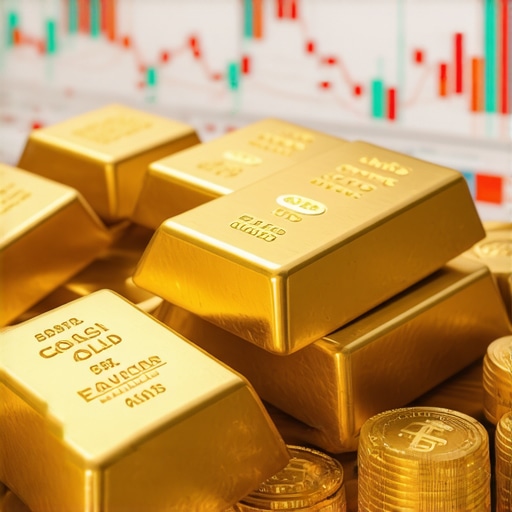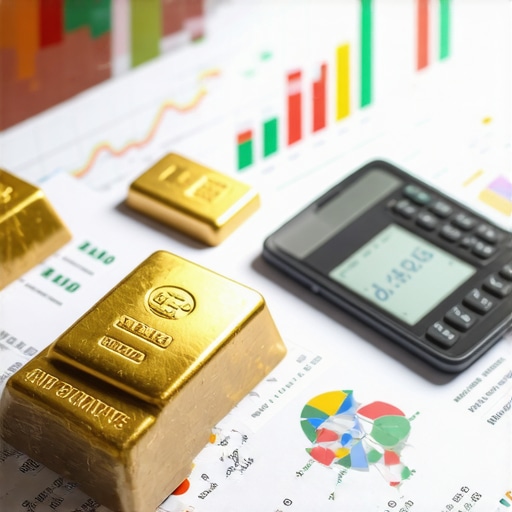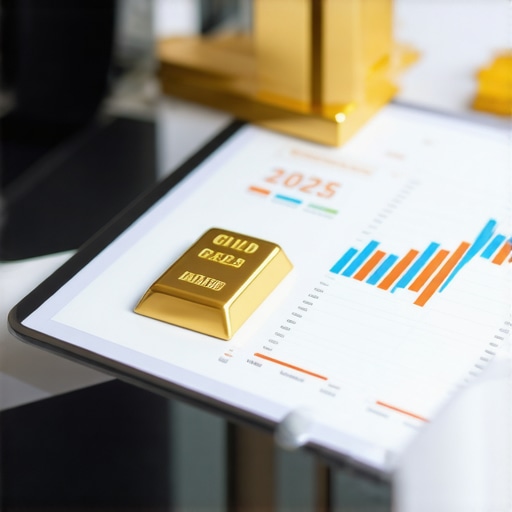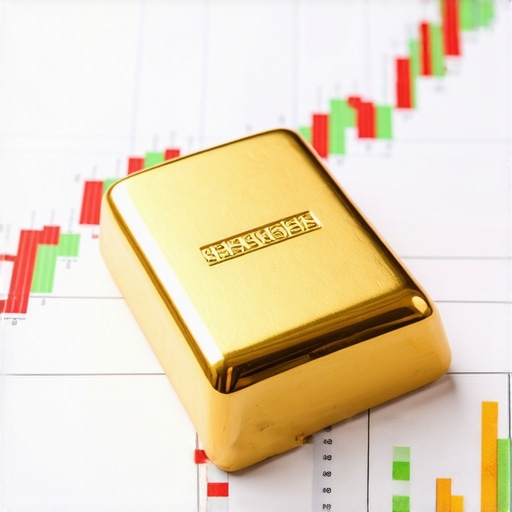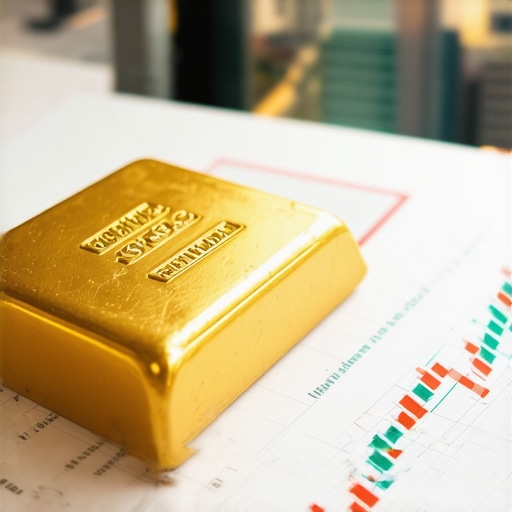Unlocking the Future of Investment: Why Gold ETFs & Mutual Funds Dominate 2025
As financial markets become increasingly complex amid global economic shifts, investors seeking stability and growth are turning toward precious metals, particularly gold. The strategic inclusion of gold ETFs and mutual funds in investment portfolios not only hedges against inflation but also provides exposure to gold’s unique market dynamics. In 2025, understanding the nuances of these instruments is critical for crafting a resilient, diversified wealth strategy.
Deciphering the Role of Gold in Modern Portfolio Diversification
Gold’s reputation as a ‘safe haven’ remains robust, especially when macroeconomic uncertainties such as inflationary pressures and geopolitical tensions prevail. Gold ETFs (Exchange-Traded Funds) and mutual funds offer liquidity, transparency, and ease of access, making them suitable for a broad spectrum of investors. Their performance, however, is influenced by various factors including global economic conditions, central bank policies, and demand trends.
What Are the Most Promising Gold ETFs & Mutual Funds in 2025 for Diversified Investment?
Leading options like the SPDR Gold Shares (GLD) and iShares Gold Trust (IAU) continue to attract investor interest due to their low expense ratios and high liquidity. Additionally, sector-specific mutual funds focusing on gold mining stocks provide leverage to gold price movements, adding another layer of diversification. It is vital to evaluate fund holdings, management strategies, and expense structures before selection, as these parameters significantly impact long-term returns. For a comprehensive review, explore top gold ETFs & mutual funds for 2025.
Analyzing the Market Dynamics that Shape Gold Investment Strategies
Global economic indicators such as inflation rates, currency fluctuations, and geopolitical developments directly influence gold prices. Central bank gold purchases are particularly telling; increased buying often signals confidence in gold as a reserve asset amid currency devaluations. Moreover, emerging demand trends, like jewelry consumption and technological uses, further underpin gold’s value proposition. A thorough analysis of market drivers can help investors anticipate price movements and align their holdings accordingly.
Expert Insights on Gold Investment Strategies for 2025
Professionals suggest adopting a layered approach: combining physical gold holdings with ETFs and mining sector mutual funds. This strategy enhances diversification and mitigates risks associated with market volatility. For instance, a balanced allocation might allocate 40% to physical gold, 35% to ETFs, and 25% to sector-specific mutual funds. Furthermore, leveraging technical analysis tools and futures trading strategies can optimize entry and exit points, maximizing returns in fluctuating markets. For detailed tactical guidance, see effective gold trading strategies for 2025.
Conclusion: Preparing for 2025 with Informed Gold Investment Choices
As the landscape of gold investments evolves, staying informed about geopolitical developments, economic indicators, and market sentiment remains essential. By integrating sophisticated ETFs and mutual funds into a well-structured portfolio, investors can harness gold’s potential to safeguard wealth and generate sustainable growth. Continuous analysis and strategic rebalancing, supported by expert insights and market data, will be the cornerstone of successful gold investment in 2025.
Explore comprehensive resources and share your insights with fellow investors to stay ahead in this dynamic market. For further expert perspectives, visit investing in gold stocks and mining shares for 2025.
Unlocking the Power of Demand Trends: How Emerging Sectors Influence Gold Prices in 2025
Understanding the diverse demand sectors for gold is essential for investors aiming to optimize their portfolios. While jewelry remains a significant driver, technological applications such as electronics and renewable energy storage are gaining momentum, contributing to a steady increase in gold’s industrial demand. This diversification of demand sources makes gold a resilient asset, less vulnerable to traditional market shocks. Analyzing these trends through comprehensive reports like gold demand trends in 2025 provides critical insights into future price trajectories.
Can Central Bank Policies Continue to Drive Gold Accumulation?
Central banks worldwide are increasingly viewing gold as a strategic reserve asset, especially amid currency devaluations and geopolitical tensions. Their purchasing behaviors, whether in accumulating or divesting gold reserves, significantly impact market sentiment and prices. For example, recent data from the central bank gold purchase reports indicate a pattern of sustained buying, signaling confidence in gold’s stability. Monitoring policy shifts and reserve adjustments can help investors anticipate market movements and adjust their holdings accordingly.
How Can Investors Leverage Advanced Tools to Maximize Gold Investment Returns in 2025?
Employing technical analysis, futures contracts, and algorithm-driven trading strategies can significantly enhance return potential. Tools such as trend lines, moving averages, and RSI indicators allow investors to identify optimal entry and exit points amidst volatile markets. Moreover, integrating these techniques with fundamental analysis of macroeconomic indicators creates a comprehensive approach. For practical guidance, explore effective gold trading techniques for 2025. Staying informed about real-time market data and leveraging automated trading systems can further refine decision-making processes.
For deeper insights into developing robust strategies, consider reviewing building a long-term gold investment portfolio for 2025 and beyond. Sharing your experiences and strategies with fellow investors can also foster collective growth and resilience in navigating this complex market landscape.
Harnessing Quantitative Analysis to Forecast Gold Price Movements in 2025
As we delve deeper into 2025, the integration of quantitative models becomes indispensable for sophisticated investors seeking an edge in gold markets. Utilizing machine learning algorithms, neural networks, and econometric models allows for the synthesis of vast datasets—covering macroeconomic indicators, geopolitical events, and market sentiment—to generate predictive analytics with high precision. For instance, a study published in the Journal of Alternative Investments (2024) demonstrated the efficacy of vector autoregression models in anticipating short-term gold price fluctuations based on interest rate dynamics and currency movements (source). Implementing such advanced tools necessitates a multidisciplinary approach, combining financial expertise with data science proficiency.
What Are the Best Computational Techniques for Modeling Gold Price Volatility in 2025?
Techniques like GARCH (Generalized Autoregressive Conditional Heteroskedasticity) models are particularly effective in capturing the clustering of volatility inherent in gold prices. These models can help investors optimize their entry and exit points by forecasting periods of heightened market turbulence. Additionally, reinforcement learning algorithms, which adapt based on real-time feedback, are gaining traction for dynamic portfolio rebalancing amid fluctuating gold prices. According to a report by Oxford Economics, such AI-driven approaches can outperform traditional static models, especially in unpredictable geopolitical climates.
The Interplay of Geopolitical Risks and Gold’s Safe-Haven Status in 2025
Geopolitical tensions continue to be a primary driver of gold’s appeal as a hedge, but their influence is nuanced and multi-layered. For example, the escalation of trade conflicts or regional conflicts often triggers safe-haven flows into gold, yet the timing and magnitude depend on the broader macroeconomic context. Analyzing geopolitical risk indices—such as the Global Peace Index or the Geopolitical Risk Index—can help investors quantify these influences. The International Crisis Group (2024) emphasizes that a comprehensive geopolitical risk assessment, combined with macroeconomic analysis, enhances the strategic allocation of gold assets in a diversified portfolio (source). Moreover, emerging markets’ political stability can significantly alter demand dynamics, adding another layer of complexity to market forecasting.
How Can Investors Integrate Geopolitical Risk Assessments into Gold Investment Strategies?
One approach involves developing a geopolitical risk-adjusted beta for gold assets, which measures sensitivity to global tensions. This metric can inform dynamic rebalancing strategies—reducing exposure during periods of low risk and increasing holdings when tensions escalate. Additionally, employing scenario analysis and stress testing can prepare portfolios for extreme geopolitical events, ensuring resilience. Combining these techniques with real-time news analytics and sentiment analysis from social media platforms can further refine timing and allocation decisions, making the investment process more proactive and responsive.
Advanced Portfolio Construction: Balancing Physical Gold, ETFs, and Mining Stocks for 2025
Constructing a resilient gold-centric portfolio in 2025 requires a nuanced understanding of risk diversification and return optimization. Physical gold provides security and liquidity, ETFs offer cost-effective exposure, and mining stocks present leveraged opportunities relative to gold prices. A sophisticated approach involves dynamic allocation strategies—adjusting weights based on market signals gleaned from technical indicators, macroeconomic forecasts, and geopolitical risk assessments. For example, during periods of rising inflation expectations, increasing allocations to mining stocks could capitalize on their leverage to gold prices. Conversely, in times of heightened geopolitical tension, a move toward physical gold can serve as a more stable hedge.
Furthermore, integrating options and futures contracts enables investors to hedge against downside risks or speculate on short-term movements. According to CFA Institute research, such derivatives strategies, when executed with discipline, can enhance risk-adjusted returns and add flexibility to portfolio management.
The Future of Gold Investment: Embracing Technology for Strategic Advantage
The evolution of blockchain technology and digital gold tokens introduces new paradigms for gold investment. These innovations promise increased transparency, fractional ownership, and seamless cross-border transactions. For example, tokenized gold platforms like Goldfin and Tether Gold are expanding access to gold investments, particularly for retail investors seeking liquidity and security outside traditional channels. As regulatory frameworks mature, integrating these digital assets into a broader portfolio will become more feasible and attractive, offering diversification not just across asset classes but also across technological platforms.
To stay ahead, investors should consider developing expertise in blockchain applications, understanding regulatory landscapes, and leveraging digital gold as part of a comprehensive, tech-enabled investment approach. For further insights, explore blockchain and digital asset strategies for gold investors.
Harnessing Artificial Intelligence for Precision Gold Price Forecasting in 2025
As we advance into 2025, the integration of cutting-edge AI methodologies, such as deep learning and natural language processing, becomes indispensable for predicting gold price movements with heightened accuracy. These technologies analyze vast datasets encompassing macroeconomic indicators, geopolitical developments, and social sentiment to generate actionable insights. A notable example is the application of convolutional neural networks (CNNs) in time-series forecasting, which can identify complex patterns beyond human perception. According to a 2024 study published in the Journal of Financial Data Science, AI-driven models demonstrate superior predictive performance compared to traditional econometric techniques (source). Embracing such tools allows investors to refine entry and exit strategies, mitigate risks, and capitalize on volatility.
What are the most effective machine learning algorithms for modeling gold market volatility in 2025?
Advanced algorithms like Long Short-Term Memory (LSTM) networks and reinforcement learning are particularly adept at capturing dynamic market behaviors. LSTM networks excel in modeling sequential data with temporal dependencies, making them ideal for short-term price prediction. Reinforcement learning, on the other hand, enables adaptive trading strategies that evolve based on market feedback. Implementing these techniques requires a multidisciplinary approach, combining expertise in finance, data science, and programming. For detailed guidance, consult resources such as QuantInsti’s comprehensive guide on machine learning in trading.
Deciphering the Impact of Blockchain Innovations on Gold Investment Portfolios
The advent of blockchain technology and digital gold tokens revolutionizes the landscape of gold investment, offering unprecedented transparency, fractionalization, and liquidity. Platforms like Goldfin and Tether Gold facilitate seamless cross-border transactions and enable retail investors to diversify holdings efficiently. Moreover, the tokenization of physical gold introduces new paradigms in portfolio management, allowing fractional ownership and real-time settlement. As regulatory frameworks evolve, integrating digital gold assets into traditional portfolios will enhance diversification strategies. According to a 2024 report by Blockchain Research Institute, leveraging blockchain-enabled assets can significantly reduce transaction costs and improve portfolio resilience.
How can investors effectively incorporate digital gold tokens into their existing investment strategies?
Investors should analyze the liquidity, security, and regulatory compliance of digital gold platforms before allocation. Diversifying holdings across multiple tokens can mitigate platform-specific risks. Additionally, employing risk management techniques such as stop-loss orders and portfolio rebalancing based on market signals ensures optimal allocation. Staying informed through industry reports and regulatory updates is crucial for adapting strategies in this rapidly evolving domain.
Advanced Portfolio Optimization: Integrating Physical Gold, ETFs, Mining Stocks, and Digital Assets
Constructing a resilient gold-centric portfolio in 2025 involves a sophisticated approach that balances physical holdings, exchange-traded funds, mining stocks, and digital gold assets. Dynamic rebalancing based on macroeconomic signals, geopolitical risk assessments, and technical indicators can optimize risk-adjusted returns. For example, during inflation surges, increasing exposure to mining stocks and digital gold tokens may provide leverage, while physical gold offers stability during geopolitical crises. Incorporating derivatives like options and futures enhances hedging capabilities, allowing for fine-tuned risk management. According to the CFA Institute, employing a multi-asset approach with a focus on uncorrelated assets optimizes diversification and resilience (source).
The Future of Gold Investment: Synergizing Traditional Assets with Tech-Driven Solutions
Emerging technologies such as blockchain, AI, and quantum computing are reshaping gold investment strategies, enabling real-time analytics, automated trading, and secure digital custody. Quantum algorithms, for instance, promise to solve complex optimization problems rapidly, enhancing portfolio management precision. Simultaneously, the development of decentralized finance (DeFi) platforms introduces innovative avenues for collateralized gold loans and yield-generating strategies. Staying at the forefront of these technological advancements requires continuous learning and strategic adaptation, positioning investors to leverage new opportunities for wealth preservation and growth in 2025 and beyond. For insights into integrating these innovations, explore Morgan Stanley’s analysis on quantum computing in finance.
Expert Insights & Advanced Considerations
Investment Diversification and Risk Management
Integrate physical gold, ETFs, and mining stocks with dynamic allocation strategies informed by macroeconomic and geopolitical analyses to optimize risk-adjusted returns in 2025.
Technological Innovation & Digital Gold
Leverage blockchain platforms and digital gold tokens to enhance portfolio liquidity and transparency, ensuring compliance with evolving regulations for seamless integration into traditional assets.
Quantitative & AI-Driven Forecasting
Employ machine learning algorithms such as LSTM networks and reinforcement learning to model volatility and predict short-term gold price movements, gaining an edge in fast-moving markets.
Geopolitical Risk Assessment
Develop geopolitically risk-adjusted betas and scenario analyses to dynamically rebalance gold holdings, safeguarding against regional conflicts and macroeconomic shocks.
Emerging Demand & Supply Dynamics
Stay informed on sectors like technology, renewable energy, and jewelry demand trends through authoritative reports to anticipate future price drivers and supply constraints.
Curated Expert Resources
- World Gold Council: Offers comprehensive reports on gold demand, supply, and market trends, crucial for deep market understanding.
- Bloomberg Terminal: Provides real-time data, analytics, and news insights essential for high-frequency trading and macroeconomic analysis.
- Journal of Financial Data Science: Features advanced research on AI and machine learning applications in financial markets, including gold forecasting models.
- CFA Institute: Supplies best practices in portfolio management, derivatives, and risk mitigation strategies tailored for sophisticated investors.
- Blockchain Research Institute: Delivers insights into blockchain innovations, digital assets, and their implications for gold investments.
Final Expert Perspective
Mastering the nuances of gold investment in 2025 demands a blend of traditional wisdom and cutting-edge technology. Combining expert market analysis with advanced tools like AI and blockchain can unlock new levels of portfolio resilience. Engage with these authoritative resources and continually refine your strategies—your proactive approach will define success in this evolving landscape. For professional insights and to share your strategies, explore our comprehensive guides and community discussions—your journey to strategic excellence starts here.






